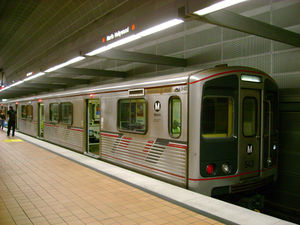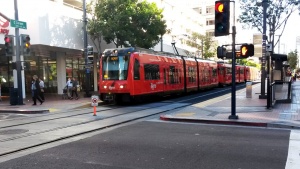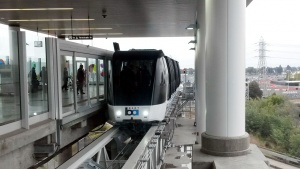Difference between revisions of "Rail transit"
m (Text replace - "Altamont Commuter Express" to "Altamont Corridor Express") |
m (→=Hybrid rail) |
||
| (4 intermediate revisions by the same user not shown) | |||
| Line 1: | Line 1: | ||
| − | + | [[File:Redsub.jpg|right|300px]] | |
| − | + | Rail transit encompass various public transit lines that operate on tracks. Historically, public transit lines began in most cities in the 19th century with rail vehicles (horse or steam propelled, later cable and electric propelled). As automotive technology advanced and roadways improved, many rail lines were converted to buses during the Great Depression and after World War II. Today only some pre-World War II rail transit systems remained. Other rail transit systems were constructed since the 1960s to provide a high speed, high capacity alternative to buses and freeways. | |
| − | + | Rail transit service vary depending on the infrastructure and operating environment. | |
| − | + | ==Types of rail transit== | |
| + | ===Street railway=== | ||
| + | Rail vehicles that primarily run on the streets similar to buses, providing local transit service. | ||
| − | + | * [[Historic streetcar]] - Service using actual historic vehicles or historic replicas. Some lines provide key transit service while some operate as tourist/excursion trips. | |
| + | * [[Modern streetcar]] - Service using modern vehicles. | ||
| − | == | + | ===Light rail=== |
| − | + | [[File:5thavestn.jpg|right|300px]] | |
| + | [[Light rail]] is a lower capacity rail mode that can operate on-street and other off-street environments including subways. | ||
| − | + | ===Rapid transit=== | |
| + | [[Rapid transit]] (or heavy rail) is a high capacity rail mode that operate on segregated right of way mostly on elevated structures or in subways. | ||
| − | == | + | ===Commuter rail=== |
| − | + | [[Commuter rail]] is a mode where trains operate according to railroad rules and can share tracks with intercity and freight trains. Many commuter rail routes are of commuter nature (picking up from the suburbs and going to downtown) and have limited or no service during off peak hours, in non-commute direction, and on weekends. | |
| − | [[ | + | ===Hybrid rail=== |
| + | [[Hybrid rail]] is a newer form of rail transit combining characteristics of light rail and commuter rail. These systems use lighter weight, short diesel multiple unit trains on railroad corridors. | ||
| − | + | ===Automated people mover=== | |
| + | [[File:Bartoac.jpg|right|300px]] | ||
| + | [[Automated people mover]] is a transit mode with driverless vehicles, operate in a grade separated environment similar to heavy rail, but operate on short routes essentially functioning as a horizontal elevator. | ||
| − | == | + | ===Intercity trains=== |
| − | + | Inter-city trains generally mean trains traveling long distances connecting metropolitan areas. Although the distances covered by some of these trains are comparable to airlines, inter-city trains generally operate at highway speed. Long distance inter-city trains may provide amenities not found on most other forms of transportation, including sleeper-cars and cafe/dining cars. | |
| − | + | [[Amtrak]] is the operator of inter-city trains in the United States. | |
| − | |||
| − | |||
| − | |||
| − | |||
| − | |||
| − | |||
| − | |||
| − | |||
| − | |||
| − | |||
| − | |||
| − | |||
| − | + | ===High speed trains=== | |
| + | High speed trains are generally defined as trains that can operate 125mph or faster. High speed trains generally connect large metropolitan areas (with very few stops in between) and are competitive with airlines in terms of overall travel time for short and moderate distance. | ||
| − | [[Category: | + | {{transit modes}} |
| + | [[Category:Transit modes]] | ||
Latest revision as of 17:37, 19 May 2019
Rail transit encompass various public transit lines that operate on tracks. Historically, public transit lines began in most cities in the 19th century with rail vehicles (horse or steam propelled, later cable and electric propelled). As automotive technology advanced and roadways improved, many rail lines were converted to buses during the Great Depression and after World War II. Today only some pre-World War II rail transit systems remained. Other rail transit systems were constructed since the 1960s to provide a high speed, high capacity alternative to buses and freeways.
Rail transit service vary depending on the infrastructure and operating environment.
Contents
Types of rail transit
Street railway
Rail vehicles that primarily run on the streets similar to buses, providing local transit service.
- Historic streetcar - Service using actual historic vehicles or historic replicas. Some lines provide key transit service while some operate as tourist/excursion trips.
- Modern streetcar - Service using modern vehicles.
Light rail
Light rail is a lower capacity rail mode that can operate on-street and other off-street environments including subways.
Rapid transit
Rapid transit (or heavy rail) is a high capacity rail mode that operate on segregated right of way mostly on elevated structures or in subways.
Commuter rail
Commuter rail is a mode where trains operate according to railroad rules and can share tracks with intercity and freight trains. Many commuter rail routes are of commuter nature (picking up from the suburbs and going to downtown) and have limited or no service during off peak hours, in non-commute direction, and on weekends.
Hybrid rail
Hybrid rail is a newer form of rail transit combining characteristics of light rail and commuter rail. These systems use lighter weight, short diesel multiple unit trains on railroad corridors.
Automated people mover
Automated people mover is a transit mode with driverless vehicles, operate in a grade separated environment similar to heavy rail, but operate on short routes essentially functioning as a horizontal elevator.
Intercity trains
Inter-city trains generally mean trains traveling long distances connecting metropolitan areas. Although the distances covered by some of these trains are comparable to airlines, inter-city trains generally operate at highway speed. Long distance inter-city trains may provide amenities not found on most other forms of transportation, including sleeper-cars and cafe/dining cars.
Amtrak is the operator of inter-city trains in the United States.
High speed trains
High speed trains are generally defined as trains that can operate 125mph or faster. High speed trains generally connect large metropolitan areas (with very few stops in between) and are competitive with airlines in terms of overall travel time for short and moderate distance.



